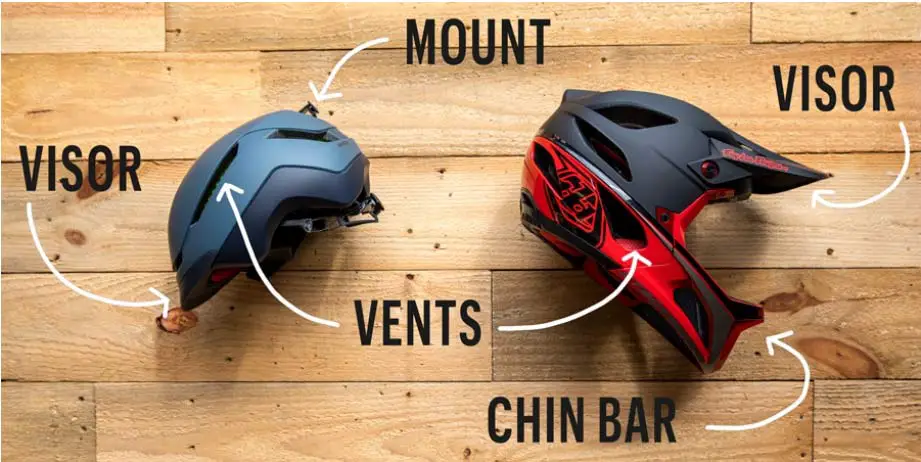Buying a used cycling helmet can be cost-effective but safety should never be compromised. Ensure the helmet meets safety standards and is undamaged.
Cycling enthusiasts often consider upgrading their gear, leaving room for budget-friendly options like used helmets.
Opting for a pre-owned helmet can be a smart choice if you’re on a tight budget or testing the waters of cycling without a hefty initial investment.
It’s crucial, however, to inspect the helmet thoroughly for any signs of wear or previous impact which could compromise its protective capabilities.
Remember, the primary function of a cycling helmet is to safeguard your head during rides, so prioritize condition over cost.
Always verify that the helmet fits properly and retains all its safety certifications to ensure maximum protection on your cycling adventures.
The Importance Of A Proper Helmet
When cycling, safety is paramount. A proper helmet can mean the difference between a minor accident and a life-changing injury. It’s essential to understand why a well-fitted, quality helmet should top your gear list, especially if you’re considering a used one.
Protecting Your Head: Why It Matters
Head protection is crucial when cycling. A fall can happen at any time, and the right helmet absorbs the impact. This reduces the risk of serious brain injuries.
- Helmets cushion your head.
- They shield your skull from direct hits.
- Quality materials manage force from a crash.
Even a used helmet must meet current safety standards. Check for a safety certification sticker inside the helmet. This ensures the helmet passed rigorous testing.
Statistical Insights: Helmet Safety Efficacy
Statistics show helmets are effective in preventing head injuries. The numbers tell a convincing story:
| Stat | Impact |
|---|---|
| 85% | Reduction in head injury risk |
| 88% | Lower risk of brain injury |
| 70% | Decrease in face injury likelihood |
These figures highlight the importance of wearing a helmet each time you ride. Even when opting for a used helmet, ensure it’s damage-free and fits properly.

Credit: www.playitagainsports.com
Types Of Cycling Helmets
Choosing the right cycling helmet is crucial for safety. Different types suit different needs. Let’s explore the types of cycling helmets available.
Road Vs. Mountain Biking Helmets
Road biking helmets are lightweight and aerodynamic. They have lots of vents. This keeps the head cool during long rides.
Mountain biking helmets offer more protection. They cover the back of the head. Some have visors and stronger straps.
| Type | Features | Use |
|---|---|---|
| Road Biking | Light, many vents | Long, fast rides |
| Mountain Biking | Extra protection, visor | Off-road, rough terrain |
Specialized Helmets For Different Cycling Disciplines
Cycling has many styles. Each style might need a special helmet. Let’s see some.
- BMX helmets are sturdy. They protect against impacts.
- Time trial helmets are super aerodynamic. They help race against time.
- Urban helmets mix style with safety. Good for city rides.
Each helmet type serves a purpose. Choose based on your cycling style.
Evaluating Used Helmets: What To Look For
Buying a used cycling helmet can save money. But safety comes first. Let’s check what to look for.
Assessing Structural Integrity
Check the helmet’s shape. It should be symmetrical. No deformations allowed.
Press down on the helmet gently. It must not crack or creak. A solid helmet means good protection.
Look inside the helmet. The padding must be intact. It should attach firmly.
Identifying Signs Of Wear And Damage
- Examine the surface. Scratches are okay. Cracks are not.
- Check for color fading. Sun can weaken helmets.
- Inspect the straps. They must not fray or tear.
- Sniff inside. A musty smell suggests mold. Mold is a no-go.
Remember, your safety is priceless. Always choose a helmet wisely.
Size And Fit: Ensuring Comfort And Protection
Finding the right size in a used cycling helmet is key. A proper fit ensures maximum protection and comfort. A helmet that’s too tight causes discomfort. One that’s too loose won’t protect well in a crash. Let’s measure your head to find that perfect fit.
Measuring Your Head For The Right Fit
Start with a flexible tape measure. Wrap it around your head, just above your eyebrows. Make sure it’s level all the way around. Note the measurement in centimeters. This number matches up to helmet sizes.
Adjusting The Helmet For Optimal Safety
Once you have your size, fine-tune the fit. Adjust the helmet’s straps and ratchet system. The helmet should sit level on your head. It shouldn’t rock back and forth or side to side. The chin strap must be snug, with only a finger’s space below your chin.
- Position: The helmet should sit level on your head.
- Straps: Adjust side straps to form a ‘V’ under your ears.
- Chin Strap: Tighten until it’s comfortably snug.
- Rear Dial: Many helmets have a dial for circumference adjustment.
Hygiene Considerations For Secondhand Helmets
Hygiene Considerations for Secondhand Helmets are key to safe use. Whether you’re saving money or recycling, cleanliness ensures safety. This guide covers essential steps to make used helmets hygienic again.
Cleaning And Disinfecting
Cleanliness is crucial for any helmet, especially a used one. Start with these steps:
- Remove any detachable parts. This includes visors and any snap-on accessories.
- Wash soft parts with mild soap and water. Gentle scrubbing removes grime.
- Disinfect hard surfaces. Use a soft cloth with disinfectant. Avoid harsh chemicals to prevent damage.
- Air dry everything. Ensure all parts are completely dry before reassembly.
Replacing Pads And Liners
For utmost hygiene, consider replacing these parts:
- Check the helmet’s interior for wear and tear.
- Measure existing pads to find the correct size replacements.
- Order new pads and liners from reputable sources.
- Install them according to the manufacturer’s instructions.
This ensures your helmet is as clean and comfortable as new.
Legal And Safety Standards For Cycling Helmets
Staying safe on two wheels means understanding the legal and safety standards for cycling helmets. A helmet is a cyclist’s best friend, serving as the first line of defense in an accident.
Let’s dive into what certification labels on helmets mean and the regulations you should follow.
Understanding Certification Labels
Certification labels on helmets indicate safety. These labels show that a helmet meets specific standards set by safety organizations. Look for labels from CPSC, CE, or ASTM. They mean the helmet passed tests for impact and strap strength.
- CPSC stands for Consumer Product Safety Commission. It’s a must in the USA.
- CE is a European standard, recognized internationally.
- ASTM is an international standard with rigorous criteria.
Helmets may have more than one label. This means they meet multiple standards. It’s a sign of a quality helmet.
Compliance With Local Regulations
Local laws vary by region. Always check your area’s helmet laws. Some places require helmets for all ages, while others focus on children under a certain age. Wearing a helmet might be optional in some locations, but safety should always be a priority.
| Age Group | Helmet Requirement |
|---|---|
| Children (Under 18) | Mandatory in many areas |
| Adults (18+) | Varies by region |
To stay updated, visit your local government website or cycling organizations. They provide the latest helmet regulations. Remember, rules can change, so keep informed.
Cost-benefit Analysis Of New Vs. Used Helmets
Choosing between a new or used cycling helmet is crucial. Safety and cost guide this decision. Let’s explore the benefits and savings of each option.
Calculating The Savings
Used helmets often cost less than new ones. Buyers can save up to 50%. It’s important to check for damage before buying. Look at these points:
- Compare prices of new and used helmets
- Inspect used helmets for cracks or wear
- Consider the helmet’s age; materials degrade over time
Longevity And Investment In Safety
Safety should never be compromised for cost. A damaged helmet can fail to protect. Keep these tips in mind:
- A new helmet has a known history
- Manufacturers recommend replacing helmets every 3-5 years
- Used helmets might not meet current safety standards
Investing in a new helmet ensures maximum protection. It comes with the latest technology. Its lifespan starts with you.

Credit: olympics.com
Where To Buy And Sell Used Cycling Helmets
Are you in the market for a used cycling helmet? Finding a high-quality, affordable option is easier than ever. With trusted platforms and safety tips, buying or selling a used helmet can be a smooth process. Let’s explore where to make the best deals on used cycling helmets.
Trusted Platforms And Marketplaces
Several online platforms offer safe, reliable transactions for cycling gear. Below are top choices:
- eBay: A vast selection of used helmets with buyer protection.
- Craigslist: Local deals, but requires in-person transactions.
- Facebook Marketplace: Connects local buyers and sellers.
- Reddit r/BikeShop: A community for cyclists by cyclists.
- Pinkbike: A dedicated bike marketplace with user reviews.
Avoiding Scams And Unsafe Deals
To ensure a safe purchase or sale, follow these tips:
- Check the helmet’s condition through photos or in person.
- Use secure payment methods with buyer protection.
- Meet in public places for local transactions.
- Verify the seller’s reputation and reviews.
- Never share personal or financial information.
Making An Informed Decision
Making an informed decision about buying a used cycling helmet involves careful consideration. It’s crucial to balance safety with cost. Let’s explore the risks and benefits of second-hand helmets and when to opt for a new one.
Weighing Risks And Benefits
Understand the pros and cons of a used helmet before buying. A table can help:
| Benefits | Risks |
|---|---|
| Lower cost | Unknown history |
| Eco-friendly choice | Potential hidden damage |
| Immediate availability | Limited lifespan |
Check for signs of wear such as cracks or a loose fit. Ask for the helmet’s history. Remember, safety comes first.
When To Choose A New Helmet Over Used
- Damaged helmets – Never buy if visibly damaged.
- Expired helmets – Helmets have a lifespan. Check the date.
- Recalled models – Avoid models with safety recalls.
Invest in a new helmet if unsure about a used helmet’s past. Your safety is worth the extra cost.

Credit: www.ebay.com
Environmental Impact Of Reusing Helmets
The Environmental Impact of Reusing Helmets is big. Reusing helmets helps our planet. It makes cycling more green.
Promoting Sustainability In Cycling
Reusing helmets is key for a greener future in cycling. It cuts down waste. This action saves resources. It shows care for our Earth.
- Less plastic in landfills
- Conserves resources like oil and energy
- Reduces pollution from making new helmets
Lifecycle Of A Cycling Helmet
A helmet’s journey is long. It starts from making to reuse. Let’s see its path.
- Manufacture: Factories make the helmet. This uses energy and materials.
- Use: A cyclist wears the helmet. It keeps them safe.
- Reuse: Instead of throwing it away, give it a new life. Another cyclist can wear it.
- Recycle: If the helmet is too old, recycling is best. This makes new things.
| Stage | Impact |
|---|---|
| Manufacture | High energy and material use |
| Use | Keeps cyclists safe |
| Reuse | Reduces waste and need for new helmets |
| Recycle | Turns old helmets into new products |
By reusing helmets, we help our planet. We also enjoy safe and sustainable cycling. Let’s choose to reuse and recycle. It makes a big difference.
Frequently Asked Questions
Are Used Bike Helmets Ok?
Used bike helmets are not recommended as they may have unseen damage compromising safety. Always opt for a new helmet to ensure maximum protection.
Can You Buy Second Hand Bike Helmets?
Yes, you can purchase second-hand bike helmets, but it’s crucial to check for damage and ensure they meet safety standards before buying.
What Can I Do With Old Cycling Helmets?
Repurpose old cycling helmets into plant pots or wall decorations. Donate them to emergency services for training purposes. Always recycle materials if possible.
Is It Legal To Resell Bike Helmets?
Reselling bike helmets is generally legal, but check local safety regulations and ensure they meet industry standards before selling.
Is Buying A Used Cycling Helmet Safe?
Purchasing a used cycling helmet can be risky as its history and potential damage from previous impacts are often unknown, possibly compromising safety.
Conclusion
Choosing a used cycling helmet can be a smart, sustainable option for riders on a budget. It’s crucial, however, to prioritize safety and condition over price alone.
By following the tips outlined, cyclists can find a reliable, cost-effective helmet, ensuring they stay protected on their journeys.
Remember, a well-selected helmet not only saves money but also promotes cycling safety for everyone.

Hels On Wheels aka Helen Dainty is a full-time global hobo cycling around the world on a budget of AU$ 100 per week. She left the UK in 2004 and has been living out of a backpack ever since.


Leave a Reply